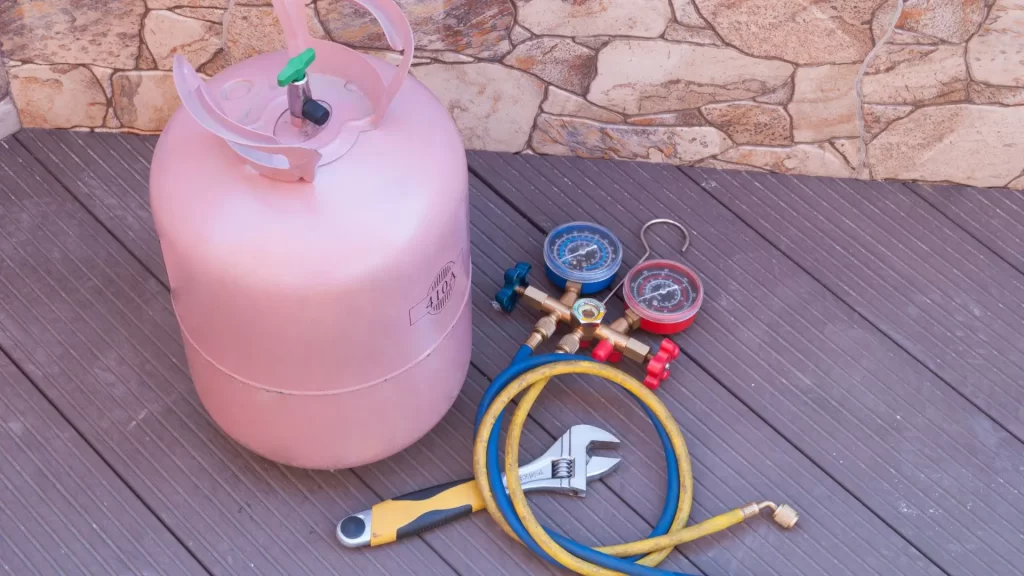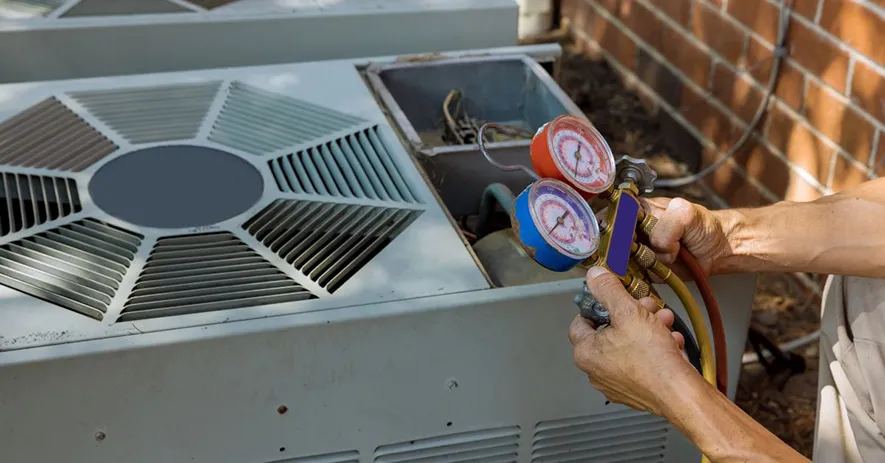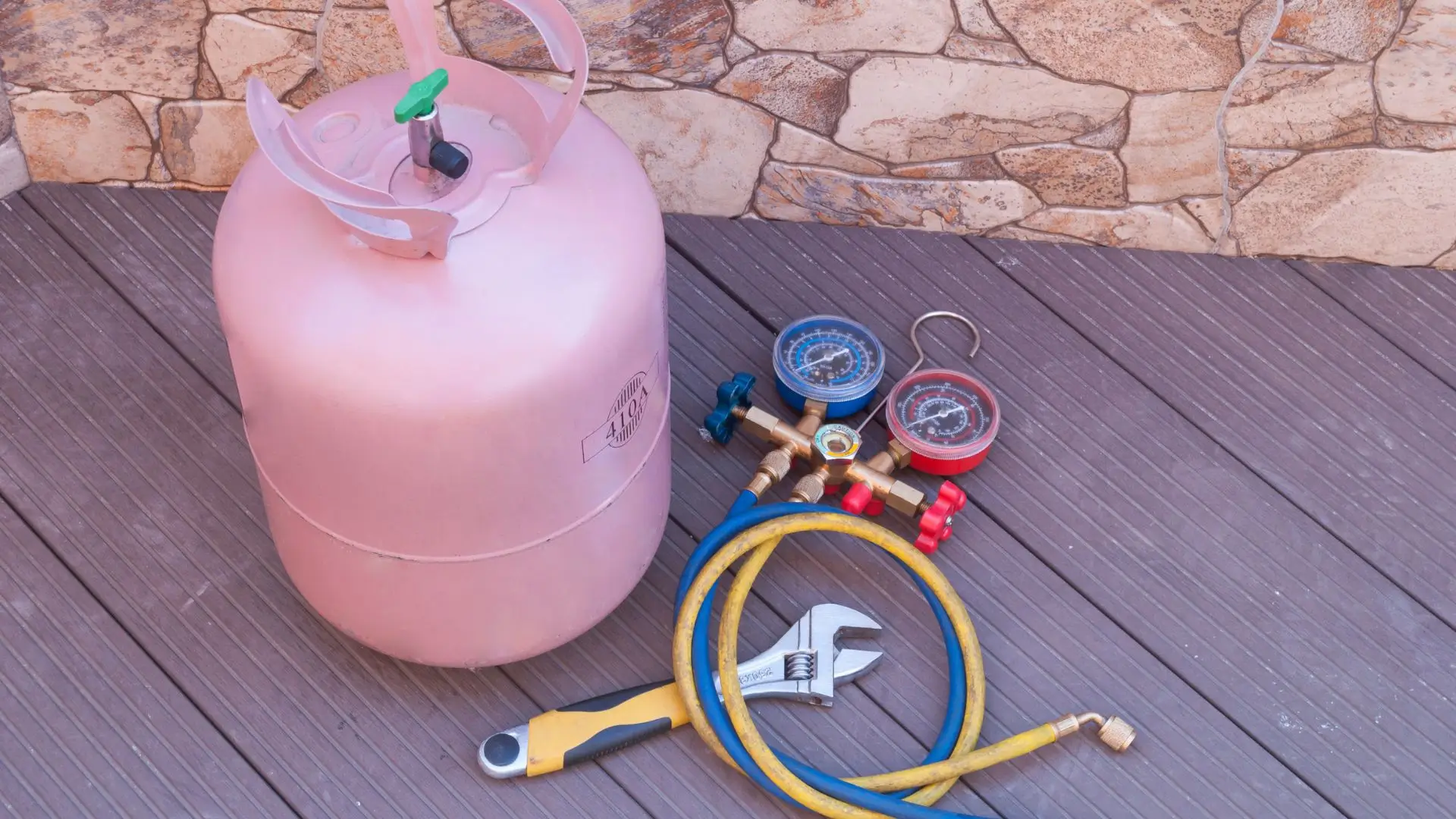Most homeowners don't spend too much time thinking about their air conditioner's expansion valve — most of the time, they don't even know it exists! However, when we talk about keeping your home cool and comfortable it plays a significant role — especially throughout the summer.
By the end of this article, you'll know what an expansion valve does, how it works, and why it's so important to your AC system's overall performance. We'll also cover some common problems you might encounter and spot the signs that it's time to consider a replacement.
Whether you're a seasoned DIY-er or a first-time homeowner, you're bound to get something out of this!

Overview of the Expansion Valve
The expansion valve controls the flow of refrigerant as it goes between two sections of your AC's system — the condenser and the evaporator. Let's take a closer look at its main parts and understand what they do. We'll also go into the details of how it contributes to keeping you cool and comfortable.
Definition And Purpose
Imagine that the refrigerant in your system is a traveler. When it begins its journey, it's a high-pressure, high-temperature liquid in the condenser. As it travels towards your evaporator, it needs to chill out so it can effectively work its cooling magic. Between the condenser and the evaporator is where the expansion valve comes in.
It acts as a gateway between the condenser and evaporator and allows "throttling" (sometimes called "metering") to occur. The expansion valve reduces the pressure and temperature of the refrigerant as it passes, allowing it to turn into a cool, low-pressure liquid. Now, the compound can absorb heat effectively when it's in the evaporator.
But that's not the end of it. The expansion valve doesn't just allow refrigerant to pass, it also determines how much goes into the evaporator. Not enough and your system begins to operate inefficiently — it might not even produce cold air. On the other hand, the compressor will flood if there's too much refrigerant, potentially leading to damage.
The expansion valve has a sensing bulb that also contains a similar refrigerant. This allows it to measure the evaporator outlet's temperature and continuously check the refrigerant's condition. The valve adjusts its opening depending on the information it gathers, resulting in proper refrigerant flow and optimized cooling performance.
Key Components And Their Functions
To really get a handle on how this little guy works, we need to take a closer look at its key components. Each part has a specific job to do, and they all work together to keep your AC running smoothly and efficiently. In this section, we'll break down the four main players: the valve body, valve pin and orifice, sensing bulb, and diaphragm or powerhead assembly. Let’s begin.
- The valve body. This is the main housing that holds all the other parts together. It's usually made of tough stuff like brass or stainless steel, so it can handle the high pressures and temperatures of the refrigerant. The valve body has two main openings: one for the liquid line coming from the condenser (the inlet), and another that leads to the evaporator coil (the outlet). Inside, you'll find the valve pin and orifice, which are like the bouncers controlling the flow of refrigerant. The valve body also has a small port that connects to the sensing bulb, so it can keep an eye on the temperature of the refrigerant leaving the evaporator.
- The valve pin and orifice. These two are like the heart and soul of the expansion valve. The valve pin is a tiny, needle-like thing that moves up and down inside the valve body, controlling the size of the opening (orifice) where the refrigerant can pass through. When the valve pin is fully seated, it's like a blockade, preventing any refrigerant from flowing. But as it starts to lift, it's like opening the floodgates, allowing more refrigerant to enter the evaporator. The exact position of the valve pin depends on the pressure and temperature readings from the sensing bulb and the diaphragm or powerhead assembly. It's all about making sure the perfect amount of refrigerant flows into the evaporator at all times.
- The sensing bulb. This little cylindrical device is filled with a similar refrigerant to what's used in your AC system. It's attached to the outlet of the evaporator coil, and its job is to keep tabs on the temperature of the refrigerant as it leaves the evaporator. As the temperature changes, so does the pressure inside the sensing bulb. This pressure change gets transmitted to the diaphragm or powerhead assembly through a small capillary tube, which then adjusts the position of the valve pin. If the refrigerant temperature is too high, the sensing bulb pressure increases, telling the valve pin to lift and let more refrigerant into the evaporator. On the flip side, if the temperature is too low, the sensing bulb pressure decreases, causing the valve pin to close and restrict refrigerant flow.
- The diaphragm or powerhead assembly. This is the part that takes the pressure changes from the sensing bulb and turns them into mechanical force to move the valve pin. It's made up of a flexible diaphragm or bellows that separates two chambers: the equalizer chamber and the powerhead chamber. The equalizer chamber is connected to the outlet of the evaporator coil and feels the same pressure as the sensing bulb. The powerhead chamber is connected to the inlet of the valve body and deals with the high pressure of the liquid refrigerant. As the pressure in the sensing bulb and equalizer chamber changes, it makes the diaphragm flex, which then moves the valve pin up or down, adjusting the flow of refrigerant into the evaporator.
So there you have it! The expansion valve's key components - the valve body, valve pin and orifice, sensing bulb, and diaphragm or powerhead assembly - are like a well-oiled machine, working together to keep your AC running at its best. By understanding how each part functions, you can appreciate just how important the expansion valve is to your air conditioner's performance.
Types of Expansion Valves
The expansion valve works behind the scenes and keeps your AC running as it should. But did you know that it comes in different types? And each one has its own way of saving the day (or in this case, saving you from feeling like you're melting). Let's check out the four types of expansion valves and what sets them apart from each other.
Thermostatic Expansion Valve (TXV)
The TXV is like the OG of expansion valves. It's dependable, efficient, and always gets the job done. This valve uses a sensing bulb filled with a refrigerant-like substance to keep an eye on the temperature of the evaporator outlet. When the temperature changes, the pressure in the sensing bulb does too, causing the valve to open or close and keep the refrigerant flow in check.
The TXV is awesome at maintaining a consistent superheat (the difference between the actual temperature and the saturation temperature of the refrigerant), which helps keep your AC running like a well-oiled machine. The only downside? It can be a bit of a diva when it comes to dirt and gunk, so you've got to keep things squeaky clean. You'll usually find TXVs in residential and light commercial AC systems, where consistent cooling is the name of the game.
Electronic Expansion Valve (EEV)
If the TXV is the classic, then the EEV is the high-tech, gadget-wielding device of the future. This valve uses an electronic controller and a stepper motor to precisely regulate the flow of refrigerant based on input from various sensors. It's like having a mini-computer controlling your AC's every move.
The EEV is insanely accurate and can adapt quickly to changes in load, making it perfect for applications where conditions are constantly shifting, like in variable refrigerant flow (VRF) systems. Plus, it's not as sensitive to dirt and debris as the TXV. The only potential drawback? All that tech comes at a price, so EEVs can be a bit more of a wallet-buster upfront. But for the precise control and adaptability they offer, it's often worth the investment.
Capillary Tube
The capillary tube is like the minimalist of expansion valves. It doesn't have any fancy moving parts or electronics - it's just a long, thin tube that the refrigerant has to squeeze through. As the refrigerant passes through this narrow passage, it experiences a pressure drop, which causes it to cool down and expand.
The capillary tube is simple, reliable, and won't break the bank, making it a popular choice for small AC systems like window units or mini-splits. The downside? It's not as precise as other types of valves and can't adapt to changes in load. It's also sensitive to clogging, so you've got to keep that refrigerant clean. But for small, straightforward applications, the capillary tube gets the job done without any fuss.
Automatic Expansion Valve (AXV)
The AXV is like the strong, silent type. It doesn't have any fancy sensors or electronics - it just uses the pressure difference between the high and low sides of the system to regulate the flow of refrigerant. As the pressure difference changes, the valve automatically adjusts, maintaining a relatively constant evaporator pressure.
The AXV is simple, reliable, and low-maintenance, making it a solid choice for a wide range of applications. It's not as precise as the TXV or EEV, but it gets the job done without a lot of fuss. You'll often find AXVs in commercial refrigeration systems, where reliability and simplicity are key. The main limitation? It can't adapt to changes in load as quickly as some of the other types of valves. But for steady, reliable performance, the AXV is a trusty sidekick.
Signs Of A Faulty Expansion Valve
Your home's AC system is designed to provide cool, consistent comfort - but if that expansion valve goes haywire, you'll likely start noticing some concerning signs that something's amiss. One of the biggest red flags? A sudden drop in cooling power leaving you feeling anything but refreshed.
If it's taking way longer than normal to cool things down or certain rooms never seem to lose that sauna-like mustiness, it could very well point toward an expansion valve issue restricting refrigerant flow. You'll also want to keep an eye out for any ice buildup on those refrigerant lines or the evaporator coil itself. That frosty-looking mess typically stems from the valve sticking wide open and oversupplying refrigerant that can't keep up with evaporation.
On the flip side, you might notice warm air circulation from vents or strange hissing, gurgling noises coming from the AC equipment. Those are indications of the opposite problem - the valve being stuck closed and starving the evaporator of refrigerant. This forces your compressor to work overtime trying to keep up, which accelerates wear and tear.
Other telltale signs of potential expansion valve woes include sky-high energy bills as your system struggles inefficiently along with that dreaded short-cycling between cooling and off modes. You may even spot moisture or water leaks around the indoor air handler unit.
The moment any of those red flags start waving, it's wise to loop in the AC experts at BelRed for a professional diagnostic tune-up ASAP. Trying to tough it out with a faulty expansion valve not only compromises cooling comfort, but can lead to compressor burnouts and other expensive repair needs down the road. Don't risk it - one quick call keeps your cool!
Causes Of Valve Malfunction
Like any hardworking component, expansion valves can certainly develop some gremlins over time that disrupt their refrigerant flow regulation. A few common culprits tend to be behind those pesky valve issues:
Built-Up Gunk
It's amazing just how much dirt, dust, and debris can infiltrate those tiny valve openings when air filters get neglected. That buildup essentially chokes off refrigerant supply like a lump in a garden hose. Keeping up with routine filter changes prevents this grimy intrusion.
Installation Errors
These valves require precise sizing and integration into your AC system during installation. If a valve gets sized incorrectly or components aren't seated right, operations get thrown out of whack right from day one. Always use certified pros!
General Wear and Tear
Like any mechanical device, expansion valves simply wear out over years of constant pressure cycling, temperature swings, and vibrations from start/stop operations. Parts fatigue is inevitable without proper maintenance.
Refrigerant Contamination
When unwanted moisture, air, or particulates infiltrate your refrigerant lines, they can corrode valve interiors and restrict flow. Catching leaks fast prevents contamination that degrades performance.
The moment you start noticing potential signs of valve problems like cooling losses, ice buildup, temperature swings or leak indications, it's smart to call in the BelRed HVAC pros for a diagnostic tune-up. We can inspect the issue's root cause and get your system back to healthy refrigerant regulation quickly.
Don't let those valve rascals overstay their welcome! Consistent professional maintenance is key to catching developing problems early before they escalate into costlier repairs or full-blown breakdowns. Your cooling comfort and budget will thank you for nipping them in the bud.
When To Call A Professional
The moment you suspect your AC system's expansion valve is acting up, it's crucial to act fast. Trying to tough it out with a faulty valve will only lead to more headaches down the road as further damage occurs. Who wants to be stuck sweltering indoors amid the dog days of summer?
As soon as you notice telltale signs like cooling losses, frozen coils, warm air circulation, or strange equipment noises, it's time to call in the HVAC pros at Sunset Heating. Our certified techs know expansion valves inside and out. We can quickly diagnose the root issue and implement a long-lasting solution to restore that sweet, sweet air conditioning bliss.
And once your valve gets that TLC it deserves, consistent professional maintenance provides the best prevention against future hiccups. Routine tune-ups allow us to catch developing valve problems early before they escalate into full-blown breakdowns costing you an arm and a leg.
So stay vigilant for any potential expansion valve gremlins, and don't hesitate to call the AC Repair technicians at Sunset Heating & Cooling a shout for backup! A properly functioning valve means maximized cooling comfort for your home and family. Leaving valve problems unchecked is just asking for an uncomfortably warm "I told you so" down the road.
Assessing The Need For Replacement
As critical as your AC system's expansion valve is for regulating refrigerant flow, there comes a point when this hardworking component simply can't keep up anymore. Knowing when to opt for a full valve replacement versus repair can get tricky, but a few telling signs usually emerge.
System Age
Age tends to be one of the biggest factors in valve degradation over time. These valves are constantly cycling pressures and temperatures, creating inherent wear and tear. If your AC unit is over 10 years old and you're encountering frequent valve-related issues, replacement may make more economic sense than perpetual repairs. Proactive upgrades prevent those inevitable sudden breakdowns too.
Persistent Cooling Problems
When a valve starts deteriorating internally, it loses precision in regulating refrigerant flow to the evaporator coil. You'll likely notice inadequate cooling with some rooms feeling muggier than others no matter what you do. Constant running without hitting set temperatures points to a valve ailment.
Frozen Coil Buildup
If you peek inside the AC cabinet and see the evaporator coil completely encased in ice buildup, chances are high that the expansion valve is stuck wide open allowing excess refrigerant flooding. That icy scenario seriously inhibits cooling capacity and risks component damage if left unaddressed.
Overheated Refrigerant Lines
On the flip side, scorching hot refrigerant lines with condensation along their lengths indicate the opposite problem - a stuck closed valve choking refrigerant supply. This forces the compressor into overdrive just to move what little refrigerant is trickling through.
Strange Equipment Noises
From whistling hisses and bubbling to loud bangs and clanks, abnormal noises often accompany a faulty expansion valve. These audible indicators relate to refrigerant either leaking past the valve or experiencing turbulent flows as it squeezes through an obstructed port.
While valve repairs can provide a temporary fix, once these symptoms start compounding, the writing is on the wall. Calling Sunset Heating & Cooling for an expert diagnosis can help determine if affordable repairs remain viable or if full valve replacement delivers more cost-effective, lasting performance for your cooling system.
How to Choose The Right Replacement Valve
Okay, so your system's trusty expansion valve has officially punched its last ticket. While replacements are inevitable for any critical component, the trickier part is ensuring you select an ideal new valve model tailored seamlessly to your AC setup.
Make the wrong pick here, and you'll just be creating fresh headaches with improper refrigerant regulation all over again. But don't sweat it - by factoring in a few key equipment specifications, you can confidently find that perfect valve match.
Refrigerant Type
Probably the single most important consideration is knowing the specific refrigerant your system utilizes. Older AC units use R-22 Freon while most modern models take R-410A Puron. Using a valve designed for the wrong refrigerant chemistry is essentially flushing money down the drain through wild inefficiencies. Double-check those outdoor unit labels!
System Capacity
You'll also need to identify the cooling power capacity measured in tonnage your AC is designed to handle. Most residential systems fall in that 1-5 ton range, but selecting an undersized valve creates restrictions while oversizing leads to constant cycling issues. A valve rated appropriately for your tonnage loads is prime.
Adjustability Options
While some valves come constructed with fixed orifice openings, adjustable TXV models allow you to fine-tune refrigerant metering to perfection - ideal for handling seasonal temperature fluctuations. The extra calibration capabilities are worth considering even if it means a bit more investment upfront.
Connection Sizing
Don't forget to examine the inlet/outlet pipe dimensions on both your new valve and existing refrigerant line sets. Residential AC typically uses 3/8" or 1/2" tubing that absolutely needs to be matched perfectly. Any misalignment creates turbulence and pressure drops before you even get started.
By cross-checking all these critical specifications against your aging system's original design, you can feel confident selecting the ideal expansion valve replacement that maximizes cooling performance and efficiency for years ahead. Or better yet - loop in the Sunset Heating & Cooling team! Our certified techs can seamlessly handle your valve swap from meticulous model specification through flawless installation.
Don't Let Expansion Valve Issues Disrupt Your Summer Cooling Comfort
At the end of the day, that humble expansion valve plays a hugely important role in keeping your AC system running like a champ all summer long. This refrigerant traffic cop is solely responsible for regulating flow and temperatures between the indoor and outdoor units. When it's operating smoothly, you get blazing efficiency and premium cooling comfort throughout your home.
But when that valve starts acting up, it can create a cascade of cooling issues real fast. From icy coil buildup and reduced airflow to spiking energy consumption, a faulty valve will make its presence known quickly through disruptive symptoms. And left unchecked, those problems just intensify until you're looking at a full system breakdown.
That's why it's so crucial to have any suspected valve gremlins diagnosed promptly by certified professionals. At Sunset Heating & Cooling, our heating and cooling experts utilize specialized tools and decades of field experience to get to the root of valve issues accurately. We'll then lay out your most cost-effective repair or replacement options in straightforward terms.
Because the truth is, trying to tough it out with an aging, compromised valve just leads to disruptive cooling losses and wallet-busting utility bills down the road. Proactive replacements restore like-new efficiency while often paying for themselves through reduced energy costs over the new valve's lifetime.
So if you've noticed any potential red flags of valve problems like inadequate cooling, temperature swings, strange operation sounds, or moisture concerns, don't hesitate to give Sunset’s team of HVAC pros a call at (500) 503-5866. We'll ensure your expansion valve (and entire AC system) keeps your family comfortable without interruption through the dog days of summer!







